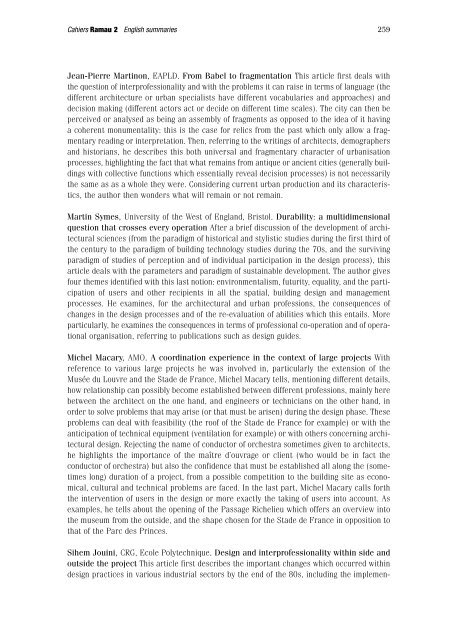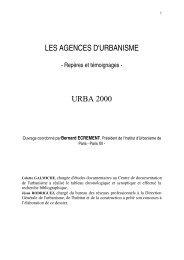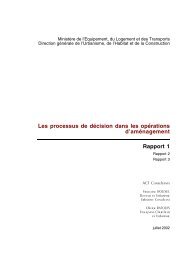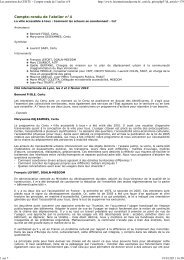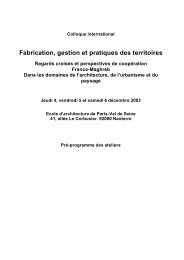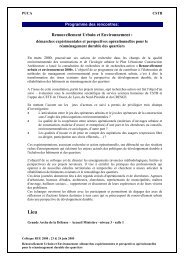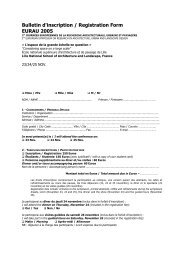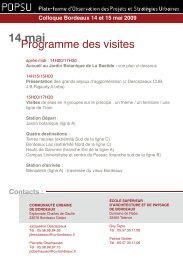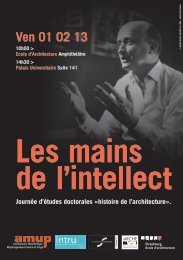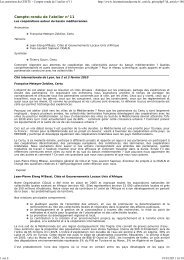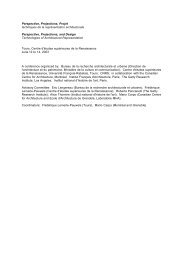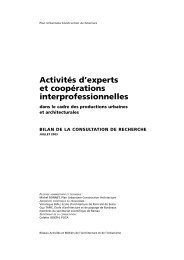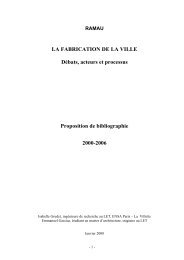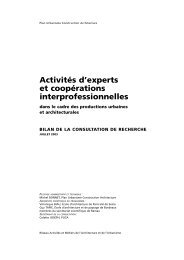Cahiers Ramau 2 en totalité
Cahiers Ramau 2 en totalité
Cahiers Ramau 2 en totalité
Create successful ePaper yourself
Turn your PDF publications into a flip-book with our unique Google optimized e-Paper software.
<strong>Cahiers</strong> <strong>Ramau</strong> 2 English summaries<br />
259<br />
Jean-Pierre Martinon, EAPLD. From Babel to fragm<strong>en</strong>tation This article first deals with<br />
the question of interprofessionality and with the problems it can raise in terms of language (the<br />
differ<strong>en</strong>t architecture or urban specialists have differ<strong>en</strong>t vocabularies and approaches) and<br />
decision making (differ<strong>en</strong>t actors act or decide on differ<strong>en</strong>t time scales). The city can th<strong>en</strong> be<br />
perceived or analysed as being an assembly of fragm<strong>en</strong>ts as opposed to the idea of it having<br />
a coher<strong>en</strong>t monum<strong>en</strong>tality: this is the case for relics from the past which only allow a fragm<strong>en</strong>tary<br />
reading or interpretation. Th<strong>en</strong>, referring to the writings of architects, demographers<br />
and historians, he describes this both universal and fragm<strong>en</strong>tary character of urbanisation<br />
processes, highlighting the fact that what remains from antique or anci<strong>en</strong>t cities (g<strong>en</strong>erally buildings<br />
with collective functions which ess<strong>en</strong>tially reveal decision processes) is not necessarily<br />
the same as as a whole they were. Considering curr<strong>en</strong>t urban production and its characteristics,<br />
the author th<strong>en</strong> wonders what will remain or not remain.<br />
Martin Symes, University of the West of England, Bristol. Durability: a multidim<strong>en</strong>sional<br />
question that crosses every operation After a brief discussion of the developm<strong>en</strong>t of architectural<br />
sci<strong>en</strong>ces (from the paradigm of historical and stylistic studies during the first third of<br />
the c<strong>en</strong>tury to the paradigm of building technology studies during the 70s, and the surviving<br />
paradigm of studies of perception and of individual participation in the design process), this<br />
article deals with the parameters and paradigm of sustainable developm<strong>en</strong>t. The author gives<br />
four themes id<strong>en</strong>tified with this last notion: <strong>en</strong>vironm<strong>en</strong>talism, futurity, equality, and the participation<br />
of users and other recipi<strong>en</strong>ts in all the spatial, building design and managem<strong>en</strong>t<br />
processes. He examines, for the architectural and urban professions, the consequ<strong>en</strong>ces of<br />
changes in the design processes and of the re-evaluation of abilities which this <strong>en</strong>tails. More<br />
particularly, he examines the consequ<strong>en</strong>ces in terms of professional co-operation and of operational<br />
organisation, referring to publications such as design guides.<br />
Michel Macary, AMO. A coordination experi<strong>en</strong>ce in the context of large projects With<br />
refer<strong>en</strong>ce to various large projects he was involved in, particularly the ext<strong>en</strong>sion of the<br />
Musée du Louvre and the Stade de France, Michel Macary tells, m<strong>en</strong>tioning differ<strong>en</strong>t details,<br />
how relationship can possibly become established betwe<strong>en</strong> differ<strong>en</strong>t professions, mainly here<br />
betwe<strong>en</strong> the architect on the one hand, and <strong>en</strong>gineers or technicians on the other hand, in<br />
order to solve problems that may arise (or that must be aris<strong>en</strong>) during the design phase. These<br />
problems can deal with feasibility (the roof of the Stade de France for example) or with the<br />
anticipation of technical equipm<strong>en</strong>t (v<strong>en</strong>tilation for example) or with others concerning architectural<br />
design. Rejecting the name of conductor of orchestra sometimes giv<strong>en</strong> to architects,<br />
he highlights the importance of the maître d’ouvrage or cli<strong>en</strong>t (who would be in fact the<br />
conductor of orchestra) but also the confid<strong>en</strong>ce that must be established all along the (sometimes<br />
long) duration of a project, from a possible competition to the building site as economical,<br />
cultural and technical problems are faced. In the last part, Michel Macary calls forth<br />
the interv<strong>en</strong>tion of users in the design or more exactly the taking of users into account. As<br />
examples, he tells about the op<strong>en</strong>ing of the Passage Richelieu which offers an overview into<br />
the museum from the outside, and the shape chos<strong>en</strong> for the Stade de France in opposition to<br />
that of the Parc des Princes.<br />
Sihem Jouini, CRG, Ecole Polytechnique. Design and interprofessionality within side and<br />
outside the project This article first describes the important changes which occurred within<br />
design practices in various industrial sectors by the <strong>en</strong>d of the 80s, including the implem<strong>en</strong>-


